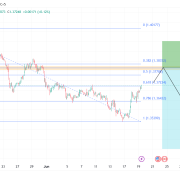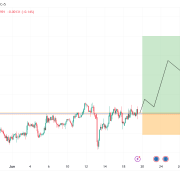
Regions Financial Corporation (NYSE: NYSE:RF) reported strong third-quarter earnings for 2024, with net income of $446 million and earnings per share of $0.49. The company saw growth in both net interest income and fee revenue, but noted cautious optimism among corporate customers due to economic uncertainty.
Key Takeaways:
• Total revenue increased due to growth in net interest income and fee revenue
• Average loans remained stable, while ending loans declined slightly
• Average deposits saw a slight decline, but ending deposits stabilized
• The company executed $101 million in share repurchases
Company Outlook
• Expects stable to modestly declining average loans for 2024
• Potential for growth in 2025 as economic and political uncertainties diminish
• Net interest income trajectory remains on track for a target of 3.60
• Anticipates modest loan growth in 2025 driven by improving economic clarity
Bearish Highlights
• Cautious optimism among corporate customers, hesitant to invest
• Slight decline in average deposits
• Decline in card and ATM fees in six of the last seven quarters
Bullish Highlights
• 3% increase in net interest income linked quarter
• Adjusted noninterest income rose 9%
• Common equity Tier 1 ratio of 10.6%
• 30% increase in deposits since 2019
Misses
• Slight decline in ending loans
• Increase in salary and benefit costs due to performance incentives
Q&A Highlights
• Charge-offs expected to remain between 40 and 50 basis points
• Deposit costs likely to decline into the fourth quarter
• No immediate plans to invest in private credit
• Focus on optimizing existing investments in M&A advisory and real estate originations
Regions Financial Corporation reported strong third-quarter earnings for 2024, with net income of $446 million and earnings per share of $0.49. The company saw growth in both net interest income and fee revenue, with nearly all fee categories improving compared to the second quarter.
Despite the positive results, Regions noted cautious optimism among corporate customers, who are hesitant to invest until there is more economic certainty. Average loans remained stable, but ending loans declined slightly, reflecting modest customer demand and credit resolutions. Average deposits also saw a slight decline, while ending deposits stabilized.
David Turner, a company executive, confirmed that the net interest income trajectory remains on track for a target of 3.60, although the fourth quarter is expected to be in the lower 3.50s. Looking ahead, Regions expects stable to modestly declining average loans for 2024, with potential for growth in 2025 as economic and political uncertainties diminish.
The company reported a 3% increase in net interest income linked quarter, and adjusted noninterest income rose 9%, driven primarily by service charges and capital markets. However, adjusted noninterest expenses increased 4%, with salary and benefit costs rising due to performance incentives.
Regions ended the quarter with a common equity Tier 1 ratio of 10.6% and executed $101 million in share repurchases. The company is focused on maintaining capital flexibility while supporting growth and returning capital to shareholders.
In terms of deposit growth, Regions reported a significant 30% increase since 2019, driven by migration into their markets and strategic investments in consumer and business accounts. The company manages approximately $8 billion in off-balance-sheet cash for corporate clients, indicating potential for rate adjustments to enhance liquidity if needed.
While the company faces challenges such as a decline in card and ATM fees, which have decreased in six of the last seven quarters, executives expressed optimism for future growth linked to an increase in checking accounts. Regions remains committed to balancing deposit and loan growth to optimize net interest margins and is focusing on expense management to generate positive operating leverage in 2025.
InvestingPro Insights
Regions Financial Corporation’s (NYSE: RF) strong third-quarter earnings for 2024 are reflected in several key metrics and insights from InvestingPro. The company’s financial health and market performance align with the reported results and outlook.
According to InvestingPro data, Regions Financial has a market capitalization of $21.8 billion USD, indicating its significant presence in the financial sector. The company’s P/E ratio of 12.32 (adjusted for the last twelve months as of Q2 2024) suggests that it’s trading at a relatively modest valuation compared to its earnings, which could be attractive to value-oriented investors.
One of the most notable InvestingPro Tips is that Regions Financial “has raised its dividend for 12 consecutive years.” This aligns with the company’s strong capital position and commitment to returning value to shareholders, as mentioned in the earnings report. The current dividend yield stands at an attractive 4.17%, which could be appealing to income-focused investors.
Another relevant InvestingPro Tip highlights that “11 analysts have revised their earnings upwards for the upcoming period.” This positive sentiment from analysts corresponds with the company’s cautiously optimistic outlook and potential for growth in 2025 as economic uncertainties diminish.
The InvestingPro data also shows a robust operating income margin of 35.35% for the last twelve months as of Q2 2024, reflecting the company’s efficiency in generating profits from its operations. This strong profitability metric supports the reported growth in net interest income and fee revenue.
It’s worth noting that InvestingPro offers additional tips and insights beyond what’s mentioned here. Investors interested in a more comprehensive analysis of Regions Financial Corporation can explore the full range of tips and data available on the InvestingPro platform.
Full transcript – Regions Financial Corporation (RF) Q3 2024:
Operator: Good morning and welcome to the Regions Financial Corporation’s Quarterly Earnings Call. My name is Christine and I’ll be your operator for today’s call. I would like to remind everyone that all participant phone lines have been placed on listen-only. At the end of the call, there will be a question-and-answer session. [Operator Instructions] I will now turn the call over to Dana Nolan to begin.
Dana Nolan: Thank you, Christine. Welcome to Regions’ Third Quarter 2024 Earnings Call. John and David will provide high-level commentary regarding our results. Earnings documents, which include our forward-looking statement disclaimer and non-GAAP information are available in the Investor Relations section of our website. These disclosures cover our presentation materials, prepared comments and Q&A. I will now turn the call to John.
John Turner: Thank you, Dana, and good morning, everyone. We appreciate you joining our call today. This morning, we reported strong third quarter earnings of $446 million resulting in earnings per share of $0.49. For the third quarter, total revenue grew on a reported and adjusted basis as both net interest income and fee revenue improved quarter-over-quarter. In fact, almost every category within fee revenue experienced growth compared to the second quarter. In line with the growth in revenue, adjusted noninterest expense increased modestly quarter-over-quarter. Average loans remained stable, while ending loans declined slightly quarter-over-quarter, reflecting modest customer demand, continued focus on client selectivity as well as further paydowns and credit resolutions in the portfolio. In general, sentiment among corporate customers remains cautiously optimistic. Despite recent interest rate cuts and the possibility of more, customers are hesitant to make capital expenditures until the resolution of the election along with the greater economic and geopolitical certainty. Our focus remains on understanding our customers’ evolving needs and providing tailored solutions to ensure we are well positioned to support them when the time is right. Average deposits declined slightly while ending deposits remained stable during the quarter as deposit remixing trends have stabilized. Although certain portfolios within the corporate bank continue to experience stress, overall, our corporate and consumer customers remain healthy and our credit metrics have stabilized. Before wrapping up, I want to take a moment to speak about the recent hurricanes, Helene and Milton. They were incredibly powerful storms and the impacted communities across our footprint face difficult challenges as they begin the recovery process. I’m extremely proud of the way our teams are responding to meet the needs of our customers, fellow associates and communities affected. Regions has a long history of helping communities through challenging times, including natural disasters and we’ll continue to support recovery efforts. In summary, we’re proud of our third quarter results driven by the successful execution of our strategic plan. Our highly desirable footprint, along with the investments we’re making in talent, in technology and in products and services are positioning us to benefit as macroeconomic conditions improve. We have a great plan and a leadership team with a proven track record of successful execution. We’re on track for a strong finish to 2024 and are well positioned to continue generating top quartile results in 2025 and beyond. Now David will provide some highlights regarding the quarter.
David Turner: Thank you, John. Let’s start with the balance sheet. Average loans remained stable while ending loans declined slightly on a sequential quarter basis. Within the business portfolio, average loans remained stable quarter-over-quarter. As John mentioned, pipelines are likely to remain soft as customers continue to seek more certainty on a handful of fronts. In addition, customers continue to carry excess liquidity and utilization rates remain below historic levels. Average consumer loans also remained stable as modest growth in credit card was offset by declines in other categories. We continue to expect 2024 average loans to be stable to down modestly compared to 2023. From a deposit standpoint, deposit balances followed expectations this quarter. Ending levels were stable and averages were down about 1%, largely due to normal summer spending among consumers. Competitive rates declined in advance of the Fed rate cut and consequently customer demand for CD softened, further slowing the rate seeking behavior we experienced throughout the cycle. As a result, the percentage of noninterest-bearing deposits remained stable in the low 30% range. Let’s shift to net interest income. Net interest income increased 3% linked quarter, outperforming our expectations. The increase reflects stability and deposit trends together with asset yield expansion. Year-to-date, we have repositioned $3.6 billion of securities, realizing $175 million of pretax losses, resulting in an estimated 2.5 year payback. This includes the incremental sales and reinvestment of approximately $1.3 billion of securities in the third quarter at a $75 million pretax loss. Importantly, the strategy of selling shorter duration and buying longer duration securities has been helpful in maintaining our duration target and has benefited the unrealized loss on the portfolio as interest rates moved lower in the third quarter. Going forward, we will continue to evaluate further repositioning with respect to risk management and capital goals. However, near-term opportunities with attractive payback periods are limited given current market dynamics. Similar to the second quarter transaction, the proceeds of $1 billion September debt issuance were used to purchase the like amount of securities in order to maintain a relatively neutral balance sheet position and bolster liquidity. As expected, interest-bearing deposit costs have peaked remaining flat with the second quarter level at 2.34%. This completes the full rising rate cycle with our interest-bearing deposit beta finishing at 43%, while also maintaining 30% more deposit balances than held prior to the pandemic. Once again, highlighting the funding advantage of Regions’ industry-leading deposit franchise. Now as we transition to a falling rate environment, hedging and the ability to reduce deposit expense result in a well-protected profile. Following the initial Fed funds decline, we’ve experienced a reduction in interest-bearing deposit rates and our exit rate for the quarter amounted to 2.2% consistent with a roughly 30% beta. In the fourth quarter, we would expect further benefit from deposits as term products begin to mature and price lower, equating to a mid-30s beta and neutral sensitivity position in the quarter. Over time, we believe falling rate deposit betas have the ability to drift higher toward those experienced in the rising rate cycle. When coupled with fixed rate asset turnover at higher market yields, this provides the support to grow net interest income in the fourth quarter and beyond. Let’s take a look at fee revenue performance during the quarter. Adjusted noninterest income increased 9% driven by improvement in almost every category, most notably service charges, capital markets and wealth management. Service charges increased 5% driven primarily by treasury management semi-annual fees as well as the benefit of one additional business day in the quarter. Capital markets increased 35% due to the increase in M&A advisory fees as well as an increased securities underwriting and placement fees driven by market stabilization. Over time and in a more favorable interest rate environment, we expect our capital markets business can consistently generate quarterly revenue of approximately $100 million, but we expect it will run around $80 million to $90 million in the fourth quarter. Wealth Management increased 5% to a new quarterly record, reflecting increased sales activity and stronger markets. Based on year-to-date results, we now expect full year 2024 adjusted noninterest income to be in the $2.45 billion to $2.5 billion range. Let’s move on to noninterest expense. Adjusted noninterest expense increased 4% compared to the prior quarter, driven primarily by a 6% increase in salaries and benefits resulting from one additional day in the quarter, increased performance-based incentives and the impact of HR-related asset valuations. The company also recognized $14 million of expense during the quarter associated with Visa (NYSE:V)’s ongoing litigation escrow related to their Class B shares. We remain committed to prudently managing expenses to fund investments in our business. We will continue focusing on our largest expense categories, which include salaries and benefits, occupancy and vendor spend. Based on year-to-date results, including outperformance in revenue and elevated HR asset valuations, we now expect full year 2024 adjusted noninterest expenses to be approximately $4.25 billion. Regarding asset quality, as John indicated, overall credit performance continued to stabilize during the quarter. And importantly, our results include the impact of the recently completed SNC exam. Provision expense was $4 million less than net charge-offs at $113 million and the resulting allowance for credit loss ratio increased one basis point to 1.79%. As expected, net charge-offs as a percentage of average loans increased 6 basis points to 48 basis points driven primarily by large information credit and one office credit. Nonperforming loans as a percentage of total loans declined 2 basis points to 85 basis points and business services criticized loans declined $171 million. We continue to expect full year 2024 net charge-offs to be towards the upper end of our 40 basis point to 50 basis point range attributable to a few large credits within our previously identified portfolios of interest. However, those losses are substantially reserved for. Let’s turn to capital and liquidity. We ended the quarter with an estimated common equity Tier 1 ratio of 10.6%, while executing $101 million in share repurchases and $229 million in common dividends during the quarter. When adjusted to include AOCI, common equity Tier 1 increased meaningfully from 8.2% to an estimated 9.1% from the second to the third quarter. The improvement reflects the benefit to AOCI from lower interest rates and our active management of the duration of the securities portfolio. Additionally, near the end of the third quarter, we transferred $2.5 billion of available-for-sale securities to held to maturity as an initial step to reduce the volatility of AOCI as we transition towards new regulatory expectations in the future. We expect to maintain our reported common equity Tier 1 ratio, consistent with current levels over the near-term. This level will provide meaningful capital flexibility going forward to meet proposed and evolving regulatory changes, along with the implementation timeline while supporting strategic growth objectives and allowing us to continue to increase the dividend and repurchase shares commensurate with earnings. With that, we’ll move to the Q&A portion of the call.
Operator: Thank you. We will now be conducting a question-and-answer session. [Operator Instructions] Thank you. Our first question comes from the line of Scott Siefers with Piper Sandler. Please proceed with your question.
John Turner: Good morning, Scott.
Scott Siefers: Good morning, everybody. Good morning. Thank you for taking the question. David, I was hoping you could sort of touch on some of the nuance within NII momentum. And I guess I’ll ask just the first and then follow-up question all kind of wrap into one. I think you’ve previously suggested the margin could push up closer to like 3.60 as we enter next year and then kind of advance from there over the next couple of years. Feels like the fourth quarter might take a little bit of a step back. Does that knock us off the track for the 3.60 and prior path? And then the follow-on is regardless, it still feels as if NII will remain on an upward trajectory. So any updated thoughts on how the pacing looks over the next few periods?
David Turner: Sure. Yes, Scott, I think the — we’re still intact with regards to that 3.60. I do think we’ll be in the lower part of the 3.50s in the fourth quarter. We’re going to grow a little bit in terms of NII as indicated. And then going into 2025, we still have benefit from the front book, back book that’s going to benefit us. We’ve had a little bit of earning asset growth too and continue to control our deposit costs. And of course we have our derivatives that naturally reset. Those are a negative carry this past quarter about $110 million. And so as rates come down, that certainly helps offset lowering rates. So that gives us confidence that we can go into next year and grow the margin.
Scott Siefers: Okay. Perfect. Thank you very much. I appreciate it.
David Turner: You’re welcome.
Operator: Our next question comes from the line of John Pancari with Evercore. Please proceed with your question.
John Turner: Good morning, John.
John Pancari: Good morning. Just first on the loan growth side. I guess if you could just give us a little more color of what you’re seeing in terms of loan demand. I know you indicated that utilization is running below historical levels. And then given that, what do you see as the catalyst really to be driving material pickup? And maybe how do you think about that pickup materializing when you look at either fourth quarter or 2025? Thanks.
John Turner: Yes. So we’ve said our customers are cautiously optimistic. I would say the environment is generally a positive one. The economy is still good, though slowing. We’ve seen some growth in middle market commercial and our energy portfolio and asset-based lending. And that’s offset by declines in the real estate book as projects are maturing and particularly in the multifamily space paying off, which offsets some of the growth we’re experiencing on the business side. We’ve had a little growth in credit card balances and our interbank originations that’s somewhat offset by the declines in mortgages, which experienced in some pay downs there. So I think activity is okay. Pipelines are softer than they were last quarter, but we still feel like we will see some modest possibly growth in loans in 2025 as there’s more certainty about the political environment as there’s more certainty about the continued direction of the economy, prices begin to moderate a bit. Businesses are still doing well. Balance sheets are strong. Margins are compressing. But customers are still making good money and we think they’ll want to invest in their business when it’s more clear. We see it have a more clear path later in 2025.
David Turner: Yes. John, it’s David. I would add that our expectation is for real GDP to be in the 2%, a little over 2% range in 2025. We obviously are in great markets and we think we can take advantage of those when the a little bit of this uncertainty that John just mentioned dissipates a bit and then get on the growth trajectory in 2025.
John Pancari: Great. Thank you for that. And then separately, on the expense side, can you maybe talk about your confidence in your upwardly revised expense expectations here. I guess barring the outperformance of revenue on the fee side, do you see other risks that could pressure expenses higher again beyond revenue related? And then how does that influence your expectation for a positive operating leverage next year?
David Turner: Sure. No, once you get to this close to the year, the expense estimate is, we’re pretty tight on that. We just don’t see anything that could take us out of the what we’ve given you from an estimate standpoint. And we’re set up, we’ve done a good job of managing our expenses. It’s an everyday thing for us. We continue to look at expense savings opportunities because we want to use some of those savings to reinvest in our business to continue to grow, which is sets us up for growth in 2025. And, yes, we will generate positive operating leverage in ’25. So we kind of don’t see anything that’s really could create major uncertainty in the fourth quarter in particular.
John Turner: Yes. Our largest expense, obviously, is salary and benefits, and that’s controllable as we calm the investments that we’re making. We have a big technology project underway, as you know. We believe that project is on track, on budget, and so don’t have a lot of concern about that at the moment either.
John Pancari: Great. Thank you. Appreciate it.
Operator: Our next question comes from the line of Ebrahim Poonawala with Bank of America. Please proceed with your question.
John Turner: Good morning, Ebrahim.
Ebrahim Poonawala: Good morning. I guess first question around credit. I think, David, you mentioned the charge-offs towards the higher end sectors you’ve talked about. Just maybe if we look forward, given where the economy today is, where your customer base is, do you think the charge-offs remains sticky in that 40% to 50% range or do we actually see a stair step function decline at some point over the coming quarters?
John Turner: Yes. Ebrahim, we look back historical, at our historic performance. It’s been kind of an average of 46 basis points of charge-offs prior to the pandemic. And we’ve indicated, we think based upon the composition of our portfolio that our charge-offs will range somewhere between 40 basis points and 50 basis points. On average, there may be a quarter where they’re modestly higher because of large exposures, maybe a quarter where they’re lower because better performance, particularly in the business portfolio. But we are seeing a really good consumer credit performance right now and I feel good about that. And again based upon the composition of our portfolio and our historical performance, we think that 40 basis point to 50 basis point range is really typical.
Ebrahim Poonawala: Understood. And I guess just one question, maybe for David, around deposit pricing. I’m just wondering did the signaling by the Fed with the first 50 basis points rate cut, given enough ammunition to actually flex deposit costs lower even if assuming we don’t get a November cut or do you think every incremental rate cut is much needed in order to be able to bring deposit cost lower?
David Turner: No, I think you should continue to expect the deposit cost to decline into the fourth quarter. We have several things working, some maturing CDs that are in that 4.25, 4.50 range going on today closer to 4. We had an exit rate. We put in the script interest-bearing cost being 2.20. So if you look at where we were for the quarter, it was 2.34. So that gives you the indication that you should continue to see the benefit of that coming down even if we don’t get another cut. Now obviously more cuts would be even further reduction in cost, but you also have to factor in the reinvestment yields on the asset side too. So we think we’re well positioned back to the first question that we got from Scott in terms of NII. We think we can continue to grow NII and the resulting in the fourth quarter and into ’25.
Ebrahim Poonawala: Got it. Thank you.
John Turner: Thank you.
Operator: Our next question comes from the line of Erika Najarian with UBS. Please proceed with your question.
Erika Najarian: Hi. Good morning.
John Turner: Good morning, Erika.
Erika Najarian: Good morning. David, I’m sorry for another question on deposit repricing. I’m wondering if you could give us a sense of the cadence over the next several quarters. So obviously some of the maturing retail and index deposits will reprice more immediately. Now how should we think about once the easy stuff has repriced, how we can look forward to deposit repricing going forward? And maybe think us through if we haven’t seen a neutral rate that wasn’t zero in such a long time. What is your typical deposit spread when the neutral rate has a level like 2.75% and 3%?
David Turner: Well, there’s several questions baked into there. So if you look at maturities, that was the first part of your question. We have right at $3 billion that will be maturing here in the fourth quarter between our retail customers, which is probably 2.5 of that number. And then we got some wealth and small business customers. But we’re not seeing the flight for yield as much as we had been. And so that’s dissipating. And as I mentioned earlier, our CDs of 4.25 to 4.50 that are maturing, new rates for CDs are closer to 4. Still trying to keep the duration tight. I guess, the average is probably closer to 5 months now with this expectation as rates were going to come down, we would have an opportunity to take care of it. From a money market standpoint, you can see a lot of the deposit shift that came out of NIB went into money market. We can continue to challenge those rates pretty quickly. And so I think we have a mechanism to be able to adjust our rates pretty quickly. At 3% Fed funds, you’re talking about deposit costs in the 1% range. So a couple of hundred basis point spread between those two. I think it was —
John Turner: Total deposit costs.
David Turner: Total deposit costs. Yes.
Erika Najarian: Got it. Very helpful. That includes — you mean including noninterest-bearing?
David Turner: Yes. Our total deposit costs.
John Turner: Yes, including noninterest-bearing.
Erika Najarian: Perfect. And John the second question is for you. A lot of the remaining challenge, so to speak, stories in banks have often been management teams and board and doing underinvestment of predecessors. And you guys have always hit the right balance of efficiency and investment. As we think about the setup for next year, David mentioned the NII trajectory, if we remove the election uncertainty, I suspect that your fees will benefit as well in 2025. Should we calibrate our expectations for expenses relative to revenue rather than just resetting it flat to up 1% or whatever it is. In other words, should the street just expect, okay, what can Regions generate revenue-wise in a better environment and just expect positive operating leverage from there?
John Turner: Yes, I think at the end of the day, we’re committing to positive operating leverage in 2025. A lot of what we do is we look at the revenue generation we’re going to have. We have our core expenses. We’re constantly challenging and we’re trying to figure out how much we can free up for investment because the more we can free up and investment, it’s not just technology and cyber or consumer compliance, it’s people. It’s putting more people on more boots on the ground in the markets that we want to continue to grow in, but we have obviously a cap in terms of how much we can do based on the revenue generation that we have. So we need to generate positive operating leverage. We think that creates shareholder value over time. And if we can generate more revenue, then we can use a bigger piece of the expense base to make those investments, but that’s where it gets calibrated to come back to generate positive operating leverage.
David Turner: I would just add, Erika, we’re committed to finding ways to eliminate expenses to use those monies to finance investments in our business. And if you look at treasury management, as an example, we’ve grown relationships by 5% year-over-year and revenues up 18% year-over-year. In wealth management, where we’ve been adding some wealth bankers and we expect to do that again next year, relationships are up 9% and assets under management are up 9%. We finally have, I think, capital markets back on track and that business is continuing to grow. It’s been a great growth story for us since 2014 when we began expanding our capabilities there. Mortgage is an area where we’re making some investment as we believe that business will improve. And then small business, we think, is an opportunity across our footprint. So we believe we have a number of pathways to grow and we intend to finance the investment in that growth through expenses, eliminating expenses that will allow us to make those investments.
Erika Najarian: Perfect. Thank you.
David Turner: Thank you.
Operator: Our next question comes from the line of Matt O’Connor with Deutsche Bank. Please proceed with your question.
John Turner: Good morning, Matt.
Matt O’Connor: Good morning. I was wondering if you guys could talk about the cards and ATM fee line. I know it’s just a few million dollars down in 2Q and not like all as impactful of the overall picture. But it was down and I was just looking at how it’s been down 6 of the past 7 quarters year-over-year. And just remind us what’s going on there. Thanks.
David Turner: Yes, Matt, that’s so you want to pick on the only one that didn’t grow, okay? That’s just really a volume thing and a mix between credit and debit and it depends on what season you’re in. You can get a little bit of noise and all that. There’s nothing systemic there that shouldn’t enable us to grow that over time. So there’s not a big story there.
Matt O’Connor: Okay. And it does seem like the risk of debit card interchange reform has quieted down. So is that a line item that you’re hopeful of growing in the future?
David Turner: Yes, I mean the way to grow that is to continue to grow customers. And so we focus on growing checking accounts and the more checking accounts we get, more cards we have in people’s hands. And I think, again, being in the markets that we’re in are going to give us the opportunity to do that, especially as we invest in people that I just talked about. So, yes, I think that’s opportunities to grow. You do point out that there is a risk there in terms of the debit interchange rules. If that goes through, it has quieted down. We don’t know that it there’s no law that says it has to change at all from where it is right now. So we’re going to continue to monitor that. But right now we don’t count that as something that will happen in 2025.
John Turner: Yes. And Matt, I’d just remind you that we’ve talked about this before, Visa publishes a power score, which is a reflection of consumer customers ‘ debit utilization, activation and utilization. And for 42 quarters in a row now, Regions’ customer base has been first in terms of power score. We have a customer base that’s very actively uses their cards, particularly debit cards. And so to David’s point, as long as we can continue to grow households, put more cards in customers’ hands. We believe that there’s plenty of opportunity to grow fee revenue associated with that category.
Matt O’Connor: All right. That’s helpful. Thank you very much.
John Turner: Thank you.
David Turner: Thank you.
Operator: Your final question comes from the line of Betsy Graseck with Morgan Stanley. Please proceed with your question.
Betsy Graseck: Hi. Good morning.
John Turner: Good morning, Betsy. Hey, good morning.
Betsy Graseck: Hey, yes, a couple of cleanups here. One just I know we talked a lot about deposit rates. And I’m wondering what’s the implication for deposit growth? And how are you thinking about that because of the fuel for the balance sheet, obviously.
David Turner: Yes, it gets back to, again, being in the markets that we’re in, a lot of migration of people and businesses into our markets. We’re making investments in people. And our core strategy of our company has been focusing on growth and checking accounts of a consumer and wealth and operating accounts of a business, including small business, where we’re really kind of putting more effort on that than we have in the past. We’re up about 30% since the pre-pandemic in terms of deposits since 2019. And so we think we have a good opportunity to grow. We have to be competitive with rates, Betsy. I mean we’re not trying to just be the low-cost provider. We’re trying to be fair and balanced and we think we’ve done that. And so we’re going to have our opportunity to grow. On the corporate banking side, we’ve managed about $8 billion of cash off balance sheet for our customers. And we’re not paying the rate that they would want. We get it for them and we get a little fee for it. But if we ever needed the liquidity for that, we could increase our rates and grow there. But we hadn’t had to do that. What we want to do is make sure we’re balancing deposit growth and loan growth to maximize our net interest margin.
Betsy Graseck: Sure. Okay. No, that’s helpful color, and I appreciate the $8 billion there in the corporate banking. The other question I just had is on the investment spend in capital markets, specifically, is there anything in capital markets that you’re thinking about investing more into power that line? And what I’m thinking about, I’m wondering is the private credit piece of the ecosystem here does continue to grow and there are opportunities for banks to help originate source, structure et cetera. And I’m wondering, is that an area that you would be looking to invest in or you would say absolutely not, there’s other things that we’re focused on. Thanks.
John Turner: I think we’re following the developments in the private credit space. And there are a couple of different models that are emerging. They’re all new. And so we’ll follow that with some interest, but we don’t have any specific inclination at this point. Much of what we’re seeing so far in the way of private credit origination in our markets are things that we’re nice to doing. So higher leverage, less covenants, just originations that don’t interest us at this point. But again, we’re following that development closely. In terms of capital markets, we’ve made some great investments. We want to continue to optimize those, seeing the benefits as an example of our investment in small and real estate originations, placement revenue. Separately, our M&A advisory platforms, both Clearsight and BlackArch rare doing well. I think we have opportunity to take advantage of the investments we’ve made and to look to potentially add some capabilities around the fringes either add-ons to those businesses or potentially some fixed income sales and trading capabilities over time. But we don’t have any burning desire to do anything other than execute well on the investments that we’ve made so far.
Betsy Graseck: Perfect. Thank you so much.
John Turner: Yeah. Thank you.
Operator: Thank you. I would like to turn the call back over to John Turner for closing comments.
John Turner: Great. Well, we appreciate your participating in our call today. Thank you so much for your interest in our company. Have a great weekend.
Operator: This concludes today’s teleconference. You may disconnect your lines at this time.
This article was generated with the support of AI and reviewed by an editor. For more information see our T&C.












